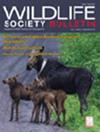利用条带数据估计德克萨斯州白翅鸽的初生羽毛脱落和孵化年代学
IF 1.5
4区 环境科学与生态学
Q3 Environmental Science
引用次数: 0
摘要
条带数据通常用于估计候鸟管理的生命率。我们使用白翅鸽(Zenaida asiatic a)的条带数据来估计德克萨斯州的脱壳和孵化年代学。我们使用了2007-2016年6月1日至8月15日期间德克萨斯州公园和野生动物部门的长期全州范围内的带羽数据(71,675只带羽个体)来调查德克萨斯州白翅鸽子的初级羽毛蜕皮和孵化。我们估计了初生羽毛的蜕皮,并使用个体重获数据来确定预测初生羽毛蜕皮率的模型的可靠性。对于孵化,我们使用捕获的孵化年鸽子的初级羽毛蜕皮分数回溯到估计的孵化日期。我们的模型预测孵化后一年的平均初级羽毛蜕皮率为13.21±0.93天。我们预测95%的成年白翅鸽在4月7日至7月8日开始蜕皮,在8月17日至11月17日完成蜕皮。在所有年份中,白翅鸽最早在1月6日孵化,最晚在7月27日孵化,95%的孵化发生在3月22日至6月18日,5月4日达到顶峰。初生羽毛蜕皮在孵化高峰后16天达到顶峰,这表明白翅鸽推迟了初生羽毛蜕皮的发生,直到繁殖活动减慢。在对候鸟进行绑带操作期间收集的次要数据可用于了解额外的生命过程,而无需启动额外的调查工作。本文章由计算机程序翻译,如有差异,请以英文原文为准。
Using banding data to estimate primary feather molt and hatch chronology of white‐winged doves in Texas
Abstract Banding data are commonly used to estimate vital rates for migratory game bird management. We used white‐winged dove ( Zenaida asiatic a) banding data to estimate molt and hatch chronology in Texas. We used Texas Parks and Wildlife Department's long‐term, state‐wide banding data (71,675 banded individuals) from 1 June to 15 August 2007–2016 to investigate primary feather molt and hatching in white‐winged doves in Texas. We estimated primary feather molt and used individual recapture data to determine reliability of models predicting primary feather molt rates. For hatching, we used primary feather molt scores of captured hatch‐year doves to backdate to an estimated hatch date. Our modeling predicted mean after‐hatch‐year primary feather molt rate of 13.21 ± 0.93 days. We predicted 95% of adult white‐winged doves began molting between 7 April to 8 July and completed molt between 17 August to 17 November. Across all years, white‐winged doves hatched as early as 6 January and as late as 27 July, with 95% of all hatching occurring between 22 March and 18 June and peaking on 4 May. Primary feather molt initiation peaked 16 days after the peak of hatching, suggesting that white‐winged doves delay the onset of primary molt until reproductive activity slows. Secondary data collected during banding operations on migratory game birds may be used to understand additional life processes without the requirement to initiate additional survey efforts.
求助全文
通过发布文献求助,成功后即可免费获取论文全文。
去求助
来源期刊

Wildlife Society Bulletin
BIODIVERSITY CONSERVATION-
CiteScore
2.10
自引率
13.30%
发文量
0
期刊介绍:
The Wildlife Society Bulletin is a journal for wildlife practitioners that effectively integrates cutting edge science with management and conservation, and also covers important policy issues, particularly those that focus on the integration of science and policy. Wildlife Society Bulletin includes articles on contemporary wildlife management and conservation, education, administration, law enforcement, and review articles on the philosophy and history of wildlife management and conservation. This includes:
Reports on practices designed to achieve wildlife management or conservation goals.
Presentation of new techniques or evaluation of techniques for studying or managing wildlife.
Retrospective analyses of wildlife management and conservation programs, including the reasons for success or failure.
Analyses or reports of wildlife policies, regulations, education, administration, law enforcement.
Review articles on the philosophy and history of wildlife management and conservation. as well as other pertinent topics that are deemed more appropriate for the Wildlife Society Bulletin than for The Journal of Wildlife Management.
Book reviews that focus on applied research, policy or wildlife management and conservation.
 求助内容:
求助内容: 应助结果提醒方式:
应助结果提醒方式:


